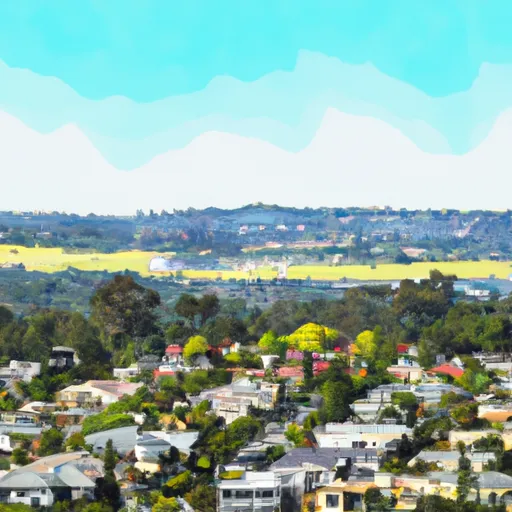-
 Snoflo Premium
Snoflo Premium
Get unlimited access to all our content
With no Ad interruptions! - Start Your Free Trial Login with existing account
Monte-Sereno
Eden Index
Climate
9.8
•
Recreation
5.1
•
Community
9.2
•
Safeguard
8.0/10

Monte Sereno, a small town nestled in the Santa Clara Valley of California, offers a delightful blend of natural beauty and outdoor recreation. With a Mediterranean climate, the area enjoys warm, dry summers and mild, wet winters. This makes it ideal for outdoor activities throughout the year.
Hydrologically, Monte Sereno benefits from being located near the Santa Clara Valley Water District's network of reservoirs and creeks. This ensures a reliable water supply and contributes to the lush greenery of the surrounding landscape.
Outdoor enthusiasts can explore the Monte Sereno Open Space Preserve, a 10-acre park with hiking trails that offer panoramic views of the valley. The nearby Lexington Reservoir also provides opportunities for boating, fishing, and picnicking. For a more extensive outdoor experience, residents and visitors can venture to the nearby Santa Cruz Mountains and enjoy activities such as hiking, mountain biking, and horseback riding.
Overall, Monte Sereno's pleasant climate, access to water resources, and proximity to natural areas make it an inviting destination for those seeking outdoor adventures and a connection with nature.
What is the Eden Index?
The Snoflo Eden Index serves as a comprehensive rating system for regions, evaluating their desirability through a holistic assessment of climate health, outdoor recreation opportunities, and natural disaster risk, acknowledging the profound impact of these factors on livability and well-being.
Climate Health Indicator (CHI): 9.8
Monte-Sereno receives approximately
631mm of rain per year,
with humidity levels near 62%
and air temperatures averaging around
15°C.
Monte-Sereno has a plant hardyness factor of
9, meaning
plants and agriculture in this region tend to thrive here all year round.
By considering the ideal temperature range, reliable water supplies, clean air, and stable seasonal rain or snowpacks, the Climate Health Indicator (CHI) underscores the significance of a healthy climate as the foundation for quality living.
A healthy climate is paramount for ensuring a high quality of life and livability in a region, fostering both physical well-being and environmental harmony. This can be characterized by ideal temperatures, reliable access to water supplies, clean air, and consistent seasonal rain or snowpacks.
Weather Forecast
Streamflow Conditions
San Francisco Bay
Area Rivers
San Francisco Bay
Snowpack Depths
San Francisco Bay
Reservoir Storage Capacity
San Francisco Bay
Groundwater Levels
Recreational Opportunity Index (ROI): 5.1
The Recreational Opportunity Index (ROI) recognizes the value of outdoor recreational options, such as parks, hiking trails, camping sites, and fishing spots, while acknowledging that climate plays a pivotal role in ensuring the comfort and consistency of these experiences.
Access to outdoor recreational opportunities, encompassing activities such as parks, hiking, camping, and fishing, is crucial for overall well-being, and the climate plays a pivotal role in enabling and enhancing these experiences, ensuring that individuals can engage in nature-based activities comfortably and consistently.
Camping Areas
| Campground | Campsites | Reservations | Toilets | Showers | Elevation |
|---|---|---|---|---|---|
| New Brighton State Beach | 102 | 93 ft | |||
| Manresa State Beach | 64 | 98 ft | |||
| Santa Cruz Port District | 12 | 14 ft | |||
| Uvas Canyon County Park | 25 | 1,098 ft | |||
| Pinto Lake Park | 28 | 119 ft | |||
| Henry Cowell Redwoods State Park | 113 | 658 ft | |||
| Sunset State Beach | 90 | 93 ft | |||
| Sunol Regional Wilderness | None | 529 ft | |||
| Seacliff State Beach | 30 | 17 ft | |||
| Sanborn - Skyline County Park | None | 1,278 ft |
Nearby Ski Areas
Catastrophe Safeguard Index (CSI):
The Catastrophe Safeguard Index (CSI) recognizes that natural disaster risk, encompassing floods, fires, hurricanes, and tornadoes, can drastically affect safety and the overall appeal of an area.
The level of natural disaster risk in a region significantly affects safety and the overall livability, with climate change amplifying these risks by potentially increasing the frequency and intensity of events like floods, fires, hurricanes, and tornadoes, thereby posing substantial challenges to community resilience and well-being.
Community Resilience Indicator (CRI): 9.2
The Community Resilience Indicator (CRI) recognizes that education, healthcare, and socioeconomics are crucial to the well-being of a region. The CRI acknowledges the profound impact of these elements on residents' overall quality of life. By evaluating educational resources, healthcare accessibility, and economic inclusivity, the index captures the essential aspects that contribute to a thriving community, fostering resident satisfaction, equity, and social cohesion.

